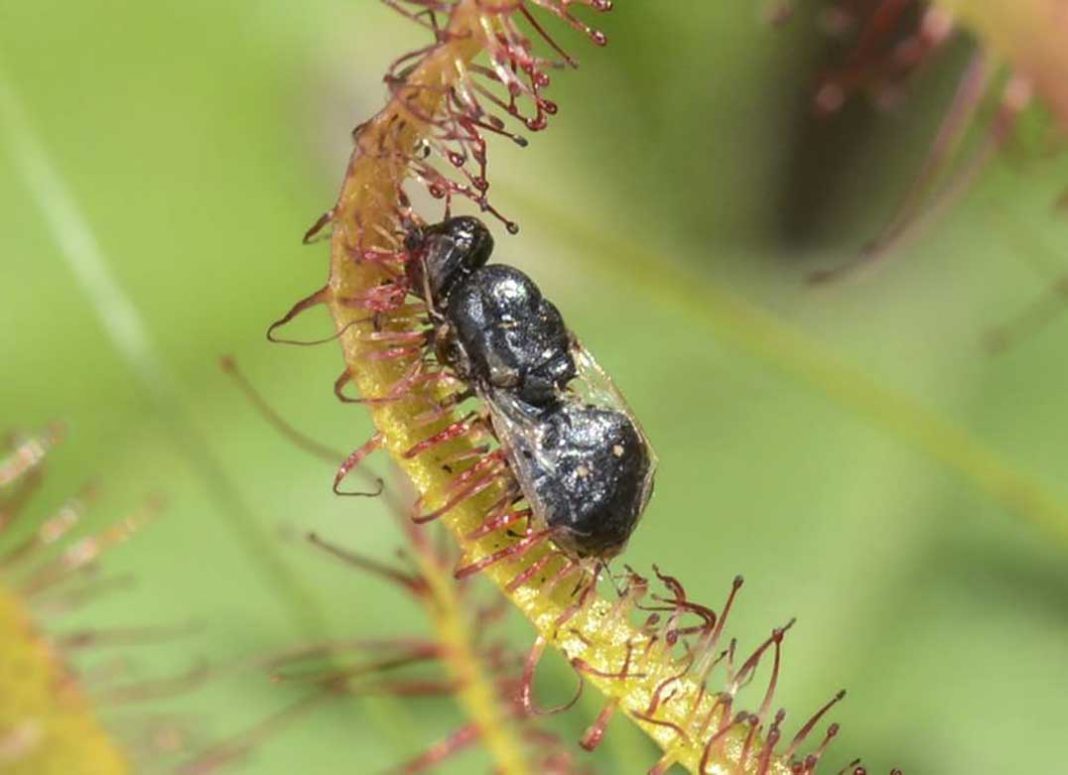An introduction to the insect-eating plants of the world’s largest freshwater island
by Joe Shorthouse, Professor Emeritus, Department of Biology, Laurentian University, Sudbury
One of the advantages of being an entomologist in this part of the world, with its temperate climate and four distinct seasons, is that during the winter months there is a break from making observations and taking photographs, and a chance to assess past discoveries.
This was the case over the past two weeks when I assembled my photographs of a subject that will be bizarre to most readers of The Manitoulin Expositor—our island is home to several species of plants that eat meat!
While we usually think of small animals such as insects being the ones eating plants, a few species of specialized plants have turned the tides and have leaves modified for trapping small animals and eating them. I was able to get close-up photographs of four kinds of Manitoulin carnivorous plants last summer and my best ones are shown here.
Carnivorous plants have intrigued and confounded biologists before the time of Charles Darwin. However, before we have visions of mammal—or people-eating plants as we saw in the movie and stage play ‘Little Shop of Horrors’ where a nerdy florist grows a plant that feeds on humans—rest assured that the ones on Manitoulin are tiny and capable of feeding on critters no larger than ants or flies.
Background to plant carnivory
Green plants typically derive most of their chemical requirements for sustaining growth and reproduction from basic but essential sources including energy form the sun, oxygen and carbon dioxide from the air, and minerals from the earth or water in which they grow.
Through photosynthesis, plants use green chlorophyll to transform sunlight into chemical energy and make carbohydrates from carbon dioxide. These carbohydrates are then used to make proteins, amino acids, vitamins and hormones.
Part of the fuel needed by these ‘chemical factories’ are minerals such as nitrogen, phosphorous, potassium, iron, etc. They are needed in such minute amounts they are seldom deficient in the environment. However, some plants have adapted to habitats such as shade, dry alvars, bogs and marshlands that are deficient in these basic requirements.

It is in the latter habitats, characterized by the presence of sphagnum moss, where carnivorous plants have developed their lifestyle. That is, these highly specialized plants overcome deficiencies in minerals and nutrients in their habitats by eating the flesh of small animals they have trapped.
Readers of nature books will note use of two terms ‘insectivorous plants’ and ‘carnivorous plants.’ When carnivorous plants were first studied, the most obvious prey was insects, hence the term insectivorous plants. However, later studies showed the remains of trapped spiders, snails, slugs, and even small frogs and salamanders. Hence the term carnivorous plants was considered more inclusive.
There are about 18 species of carnivorous plants in Canada. Manitoulin Nature Club President Marcel Bénéteau, an expert on Manitoulin plants, was able to show me four of the most common species on the Island at Lougheeds Bay on the south shore last summer.
Here we found growing on wet soil and piles of sphagnum moss, near the edge of shallow waters, carnivorous plants with the common names northern pitcher plant, round-leaved sundew and linear-leaved sundew. The fourth species, the common bladderwort, is completely aquatic and was found in shallow ponds.
The following gives a little about the biology of these meat eaters along with photographs of them dining on their prey.
Northern pitcher plant
The northern pitcher plant, with the scientific name Sarracenia purpurea, is the largest of Manitoulin’s carnivorous plants. It is in the plant family Sarraceniaceae and is the only species of pitcher plant found in Canada.
Pitcher plants are perennials that take their name from the rosette of pitcher-like or tubular shaped leaves that grow to a height of about 25 cm. The leaves arise from underground stems. There are no above ground stems except for the flower stocks, and each plant can live for 50 years.
Leaves of pitcher plants are modified in the shape of open, water-filled passive traps or pitchers that act as pitfalls for unwary foraging, flying or crawling animals (mostly insects). Insects are attracted to nectar secreted by glands found around the rim on the upper surface and they begin to slip downwards soon after they arrive.
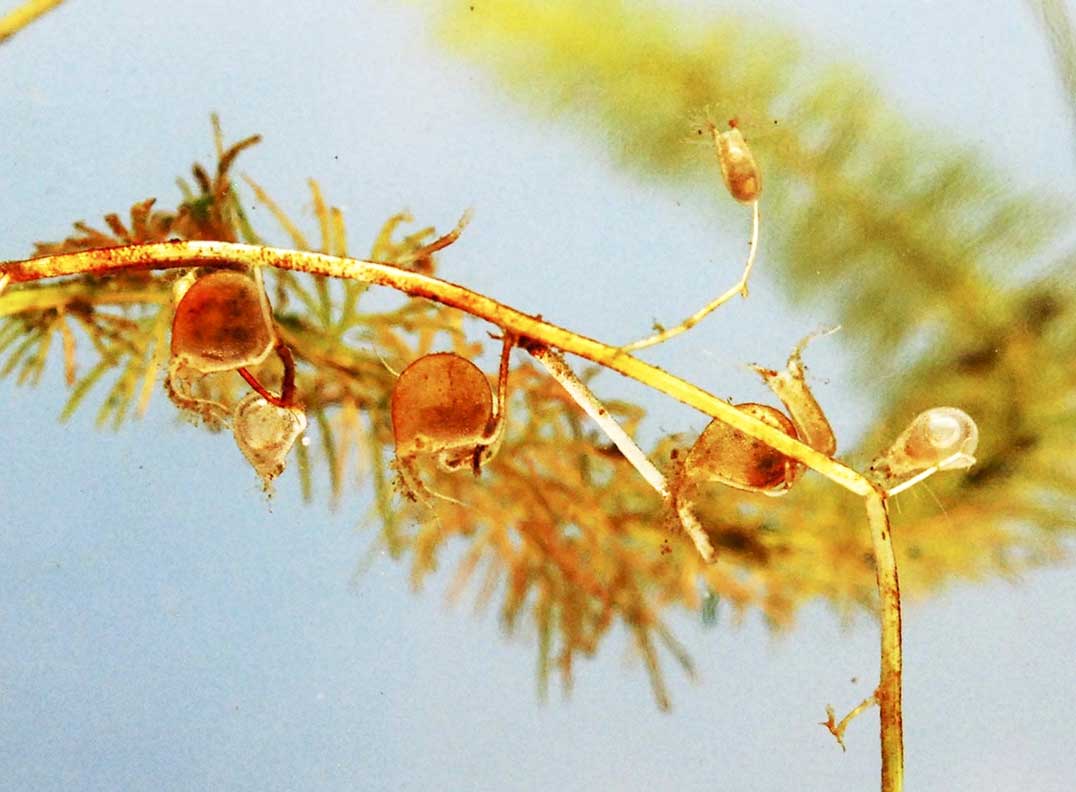
The outer surface of each pitcher is green with dark red veins. The inside surface has two distinct zones. The zone in the upper half is lined with stiff, downward pointing hairs that prevent prey from climbing upwards to escape. The surface in the lower zone is smooth and bears the glands that secret digestive enzymes into the water.
A soupy mixture of fluids at the bottom of the pitcher breaks down the flesh and exoskeletons of prey. Common prey are flies, ants, spiders and even moths, but there are records of snails, and small salamanders and frogs found in the pitchers.
A fascinating aspect of pitcher plant biology is the presence of one kind of mosquito, midge and a fly with larvae that live exclusively inside the water of pitchers and feed on drowned prey. Somehow the adults of these insects are able to fly into and out of pitchers without being captured.
Not only do the larvae of these insects avoid being killed and digested, their shredding of the drowned prey helps break down the bodies so that additional nutrients such as nitrogen are available to the plant.
Unlike the pitchers, which are deadly to unwary visitors, flowers of pitcher plants are harmless. Indeed, the flowers function like regular flowers providing insects (usually strong-flying bees) with nectar and pollen and are designed to protect pollinators from inadvertently getting caught in the pitcher.
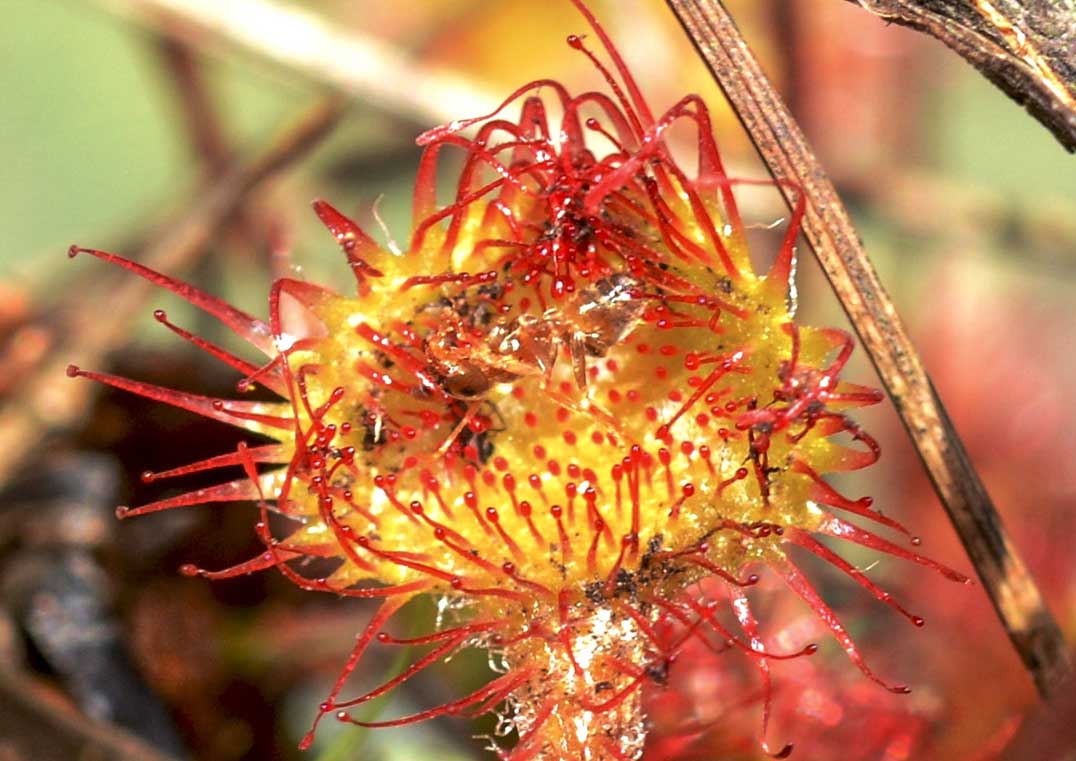
Flowers of pitchers are about five cm in diameter. They have a leather-like appearance and are bent over at the tips of long stalks, facing downwards. They have five, reddish purple petals and five thick, purplish-red sepals and look like upside-down umbrellas. The sepals appear at the top of the flower and are easily mistaken for the petals. They bloom in mid-summer.
The pitcher plant is the provincial floral emblem of Newfoundland and Labrador. It was first discovered in Quebec by Michel Sarrazin (1659-1734) who was an early Canadian surgeon, physician, scientist and naturalist.
Mr. Sarrazin was the first to suggest that pitcher plants caught and digested insects, a theory which was dismissed at the time by the academic community. It was only in 1875, when Charles Darwin published a book entitled ‘Insectivorous Plants,’ that Mr. Sarrazin’s suggestion was validated.
Mr. Sarrazin sent specimens from Quebec to the French botanist Joseph Pitton de Tournefort (1656-1708) who named the genus Sarracenia to honour Sarrazin. The specific name purpurea comes from the purple leaves and flowers. Mr. Sarrazin is considered the ‘founder of Canadian science.’
Sundews
Sundews are small, weakly rooted perennial herbs that grow close to the ground among soggy sphagnum moss on the shores of Lake Huron and around bog pools and marshes.
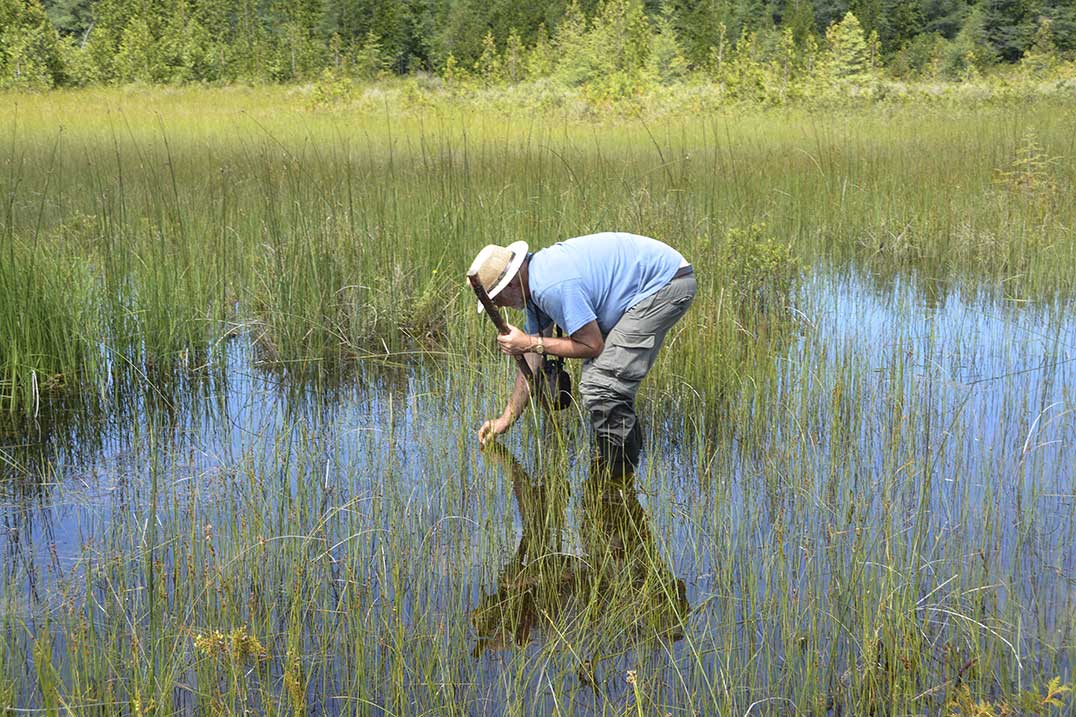
Two species, the round-leaved sundew and the linear-leaved sundew, are common on Manitoulin Island and are remarkable because their leaves are covered with hair-like tendrils that are tipped with glistening beads that attract passing insects. The leaves of both are borne on short, unbranched shoots.
Both are in the genus Drosera and plant family Droseraceae. The genus name Drosera comes from the Greek “droseros” meaning dewdrops. This is an excellent descriptor of plants with sticky secretions used to trap prey.
Both species are found in soils with little nutrients where competition with other plants is limited. They grow fully exposed to the sun making the sticky hairs glisten.
Sphagnum has an impressive ability to retain moisture which therefore makes it an ideal substrate to keep sundews hydrated. Growing in highly saturated, acidic environments lacking true “soil” resulted in sundews evolving a carnivorous way of life to supplement their diet.
Insects or other small prey that land or walk onto the leaves of sundews to investigate or that are attracted to the bright, shiny colours or the sweet nectar within the ‘dewdrops’ are instantly trapped in a sticky mess. Squirming stimulates nearby tendrils to bend and enclose the prey.
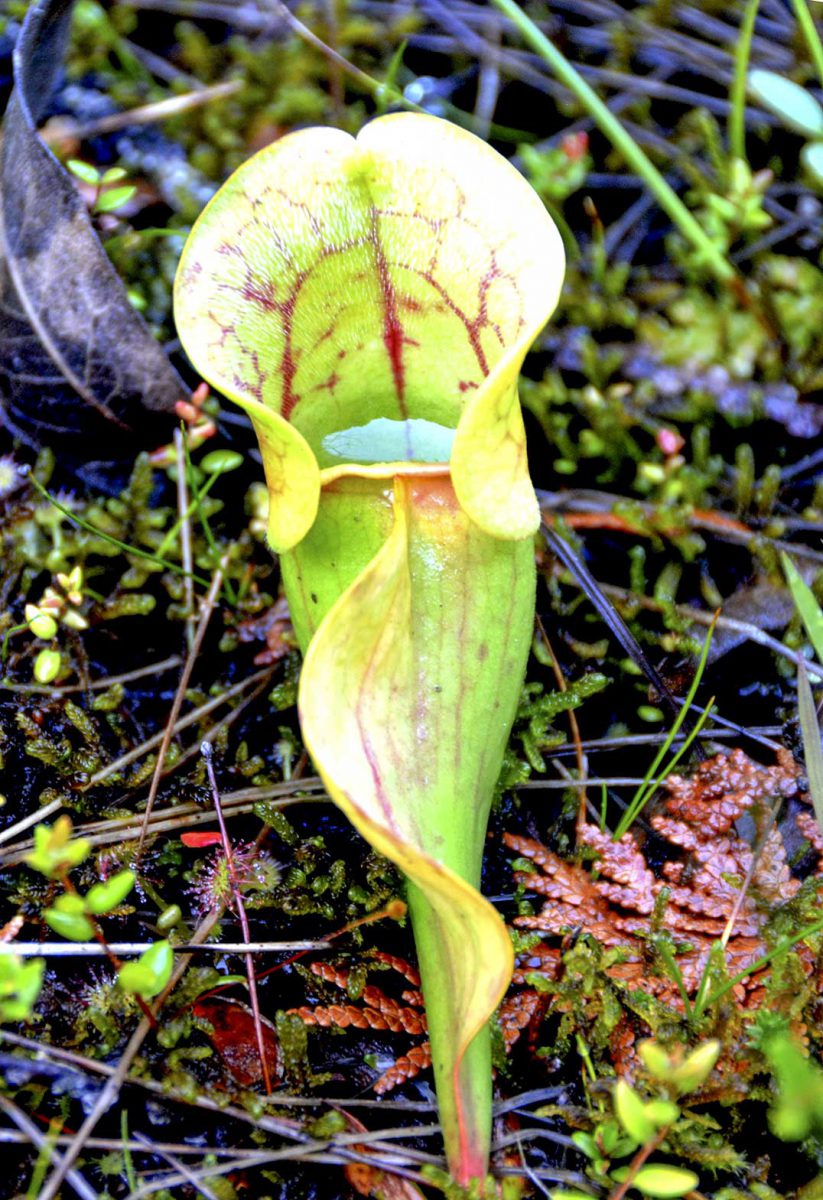
In some cases, the entire leaf may bend around the prey. Rendered immobile, the prey is killed and their tissues broken down by digestive enzymes. After the plant has extracted nutrients from its meal, the leaf opens and undigested parts of the corpse drop to the ground.
Interestingly, sundews are able to tell the difference between organic and inorganic material. Leaves will react to both tiny pieces of an insect and a pebble placed on a leaf. However, in the case of the pebble, the plant soon recognizes the deception, the leaf opens and the non-food item drops off. Leaves will not secrete digestive enzymes when they detect inorganic material stuck to their leaves.
Full grown plants of round-leaved sundew, Drosera rotundifolia, are circular or rosette-shaped and low to the ground. They have circular, bright red leaves that are splayed out and arise from a central core. Each plant is about 5-8 cm in diameter with leaves that arise from ground level and are about 5 mm in length.
Flowers of round-leaved sundew are small with five petals. They are white and borne in late summer at the end of red stems that arise from the centre of the leaf rosette. They open only in bright sunshine. Of interest, they attract pollinating insects but are far enough away from the leaves so as not to entrap them. Also interesting is that some bog-dwelling ants are able to pilfer the captured prey for themselves without becoming entangled.
Like the round-leaved sundew, the linear-leaved sundew, with the scientific name Drosera linearis, is a small, inconspicuous, ground-hugging plant with a rosette of leaves growing from a central core. Each cluster of leaves is about 10 cm across and the leaves are about 10 mm in length and about two mm wide. As the specific name linearis suggests, the leaves are long and strap-shaped.
Each leaf is covered with thin tendrils tipped with a glassy, mucilage-tipped bead of sticky moisture. When small insects land on the leaves, the leaf curls around the body until it is fatally trapped. Flowers of linear-leaved sundews are similar to those of the round-leaved sundew.
Bladderworts
The most ingenious of the meat-eaters on Manitoulin Island are small, rootless, free-floating aquatic plants called bladderworts. Bladderworts are less attractive to nature lovers than the terrestrial carnivorous species. If not for their display of flowers, bladderworts are easily missed even though they are more common than the other carnivorous species.
Bladderworts are found in the genus Utricularia which in Latin means ‘little bottle’ and refers to bladder-like structures on the underwater stems that the plants use to trap small animals. Bladderworts are found in the plant family Lentibulariaceae.
There are at least four species of bladderworts on Manitoulin, each of which live in shallow waters and have small yellow, snapdragon-like flowers borne on stems that rise above the water surface. The two most common species are the common bladderwort (Utricularia vulgaris) and the horned bladderwort (Utricularis cornuta), so-called because of a horn-like protrusion on its flowers.

Bladderworts are comprised of branching green or brown stems about one mm in thickness from which arise whorls of fine green, feathery branches. They usually occur in strands or mats floating in quiet waters.
The bulbous traps are found along the length of the stems. The traps range in size from 0.5 to 3.0 mm across and are attached to the stem with a narrow stalk at the bottom.
Bladderworts are suction trap feeders and botanists consider their bladders as one of the most complex structures in the plant world. The tiny bladders, each about five mm across, somehow manage to pump water out of a small opening found at one end of the trap, creating a powerful vacuum within. The opening is guarded by an upper-hinged veil of plant tissue called a door. The door is weakly sealed against the entrance by a thin layer of mucilage.
The trap is brought into action when small aquatic animals such as mosquito larvae, water fleas and sometimes small fish and tadpoles brush against one of the sensitive trigger hairs around the opening. This causes the door to suddenly flip into the trap. The vacuum inside causes water to rush in along with the hapless prey. The door snaps shut, water is pumped out, and the prey is trapped. Enzymes are secreted into the bladder and the victim is digested.
Trap doors operate at speeds that rank among the fastest plant movements known, estimated at 1/460 of a second or almost twice the speed of sound; not bad for an herbaceous plant!
The aerial flowers are yellow and borne on stems that protrude from the water.
Common butterwort
Another meat-eater yet to be seen by Marcel Bénéteau or myself is the common butterwort, Pinguicula vulgaris, also in the family Lentibulariaceae. The genus name Pinguicula means ‘greasy little one’ referring to the slimy upper surface and the fatty texture of its fleshy leaves.
It is easy to recognize because the flat, yellow-green leaves are pressed to the ground in a rosette manner. When a small animal lands or walks on the leaf surface, they become stuck. Edges of the leaf then roll inwards to prevent escape and enzyme-containing fluids digest the insects.
It is alleged that butterworts are found on Michael’s Point and on Fitzwilliam Island to the southeast of Providence Bay. Visiting these sites in the summer of 2019 is high on our list of botanical adventures.
Although some people may consider the eating habits of carnivorous plants somewhat gruesome, they are fascinating and important members of the Manitoulin flora and should be examined whenever possible.

